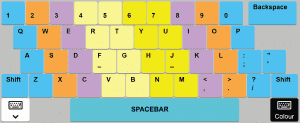Maths Invaders at Templeton Primary School
Aidan Schanssema, Director of Teaching – Numeracy, from Templeton Primary School gives insight into the use of Maths Invaders by Year 2 classes at the
As technology becomes a larger part of our lives, it becomes more and more pertinent that technological skills are accessible for all. Typing is an important skill for work and for play in this modern age. Many students who are visually impaired rely on technology to assist in their learning and everyday life. It is imperative that students are taught the fundamental skill of touch typing in an inclusive environment, to ensure correct typing practice is achieved.
There are many ways to teach typing in your classroom to cater to the individual needs of students. To begin with, it is important to ensure your students have correct posture while using the computer. The Typing Tournament Online website includes a guide to sitting positions and reminds students to have their feet flat on the floor and their backs straight, facing forward at their computer screen. The site also includes large print posters with these instructions which you are free to print out for your classroom!
Whilst there are many products that help provide accessibility options for visually impaired students, there are huge benefits to teaching these students to use standard keyboards where possible.
If a student can use a standard keyboard whilst utilising common tools (such as internal magnification) the student will be able to use computers across many environments such as the workplace and public libraries creating flexibility in their learning, work and independence.
Touch Typing is based around the principle of not needing to look at the keys. This style of teaching QWERTY keyboarding skills is of course advantageous to a visually impaired student as it will minimise the need for students to sight the individual keys or move their gaze between different objects (which may be a particular concern for some). Most keyboards include indentations on the “f” and “j” keys to help people orientate themselves by touch. Some teachers may also choose to place raised stickers on these keys, as well as the ‘Backspace’ and ‘Spacebar’ to assist beginner typists.
In general, when teaching touch typing, we at EdAlive recommend restricting visual access to the keys to stress the importance of learning hand and key placement. This will ensure the students begin to learn where the keys are through muscle memory to build their skills.
Typing Tournament also includes auditory lessons about each section of the keyboard to assist students. Whilst typing, there will be audio to indicate if a student has typed a key and within the drills a sound to notify a student of an incorrect key.
Internal magnification tools on both your device and internet browser can be adjusted to help students view web applications like Typing Tournament. Some helpful information can be found here https://www.makeuseof.com/tag/5-ways-browse-web-youre-blind-visually-impaired/ but for instructions for how to magnify please consult your web browser and operating system for specific instructions.
In the modern era, it is paramount that all students are given the opportunity to learn to touch type. Typing has become a fundamental skill, in schooling, the workplace and everyday life, which is why it is important that students with visual impairments are given the same opportunity to learn typing as their peers, in an inclusive environment.

Aidan Schanssema, Director of Teaching – Numeracy, from Templeton Primary School gives insight into the use of Maths Invaders by Year 2 classes at the

The link between speed, confidence, fluency and attainment What does a confident student look like? Motivated – an enthusiastic learner who is ready to respond

Research demonstrates that the consistent use of Maths Invaders significantly boosts students’ answer speed (confidence) and attainment (maths age) at a rate well above normal